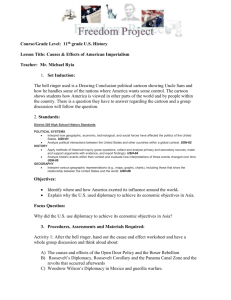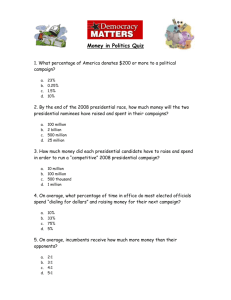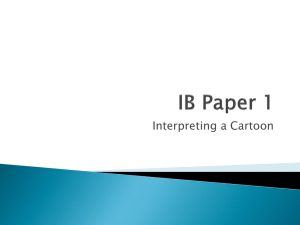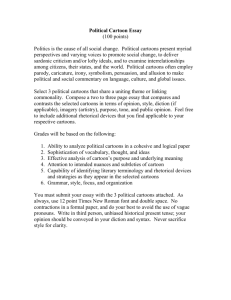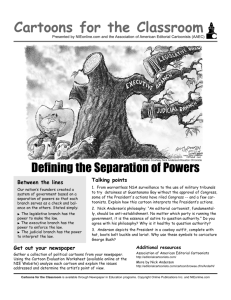Analyzing Presidential Campaign Commercials
advertisement
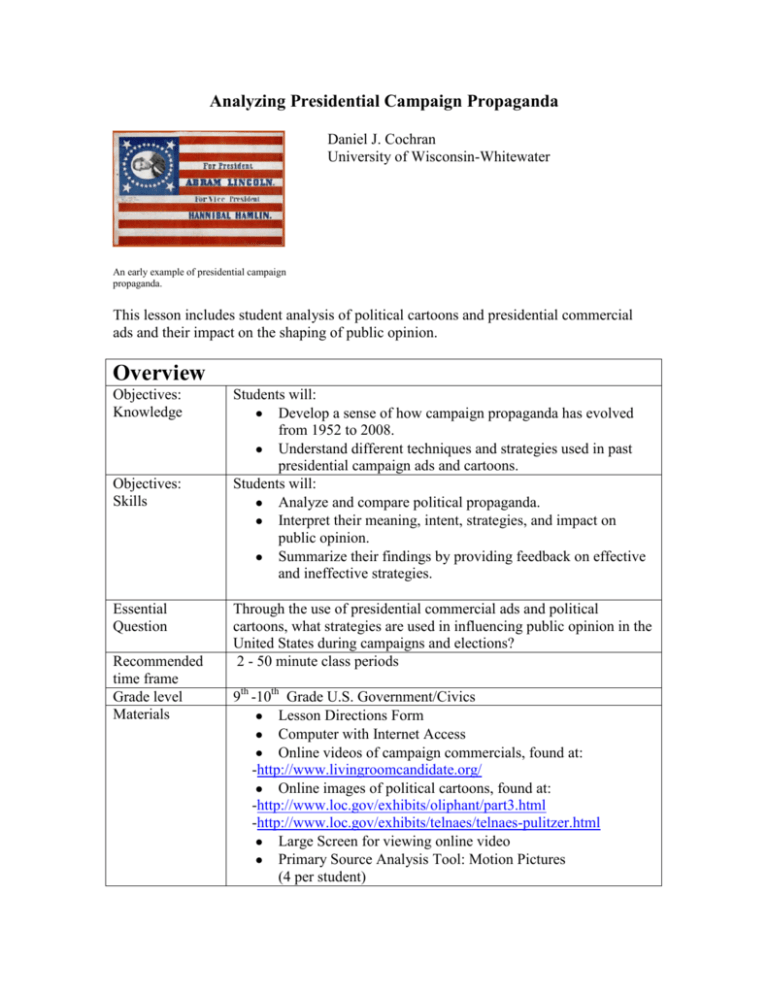
Analyzing Presidential Campaign Propaganda Daniel J. Cochran University of Wisconsin-Whitewater An early example of presidential campaign propaganda. This lesson includes student analysis of political cartoons and presidential commercial ads and their impact on the shaping of public opinion. Overview Objectives: Knowledge Objectives: Skills Essential Question Recommended time frame Grade level Materials Students will: Develop a sense of how campaign propaganda has evolved from 1952 to 2008. Understand different techniques and strategies used in past presidential campaign ads and cartoons. Students will: Analyze and compare political propaganda. Interpret their meaning, intent, strategies, and impact on public opinion. Summarize their findings by providing feedback on effective and ineffective strategies. Through the use of presidential commercial ads and political cartoons, what strategies are used in influencing public opinion in the United States during campaigns and elections? 2 - 50 minute class periods 9th -10th Grade U.S. Government/Civics Lesson Directions Form Computer with Internet Access Online videos of campaign commercials, found at: -http://www.livingroomcandidate.org/ Online images of political cartoons, found at: -http://www.loc.gov/exhibits/oliphant/part3.html -http://www.loc.gov/exhibits/telnaes/telnaes-pulitzer.html Large Screen for viewing online video Primary Source Analysis Tool: Motion Pictures (4 per student) Primary Source Analysis Tool: Cartoons (2 per student) -Copies of each found at: http://www.loc.gov/teachers/usingprimarysources/guides.html NCSS Theme(s) and Wisconsin State Standards NCSS Themes Power, Authority, and Governance Understanding the historical development of structures of power, authority, and governance and their evolving functions in contemporary U. S. society. In exploring this theme, students confront questions such as: What is power? How is it gained, used, and justified? Science, Technology, and Society Modern life as we know it would be impossible without technology and the science that supports it. But technology brings with it many questions: How can we manage technology so that the greatest number of people benefit from it? How can we preserve our fundamental values and beliefs in the midst of technological change? Wisconsin State Standards B.12.2 Analyze primary and secondary sources related to a historical question to evaluate their relevance, make comparisons, integrate new information with prior knowledge, and come to a reasoned conclusion C.12.9 Identify and evaluate the means through which advocates influence public policy C.12.11 Evaluate the ways in which public opinion can be used to influence and shape public policy Procedures Day One: Introductory: Explain to students the importance of Presidential ads and propaganda in the modern day campaign and election cycle. Explain how various strategies can be used through the use of media (5 minutes) Hand out Direction Form to each student and explain, 4 Primary Source: Motion Picture Analysis Worksheets to each student, and 2 Primary Source: Cartoon Analysis Worksheets to each student (3 minutes) Main Activity: The teacher will load the videos up on the big screen, white board, or smartboard using the following website: http://www.livingroomcandidate.org/. (Students can do this on individually if multiple computers are available). Teacher will play each video one at a time, two-three times each. Each student will be responsible for viewing four of the eight television commercial ads and filling out their motion picture analysis tool for each. (25 minutes) Next, the teacher will put four political cartoons on the main screen; found at the following websites: http://www.loc.gov/exhibits/oliphant/part3.html http://www.loc.gov/exhibits/telnaes/telnaes-pulitzer.html Each student will choose two of the cartoons and analyze each using the cartoon analysis worksheet provided. There are questions on each worksheet to guide the students in their analysis. (15 minutes) Day Two: Guided Practice: Using their completed analysis tools, students will write a one page summary of their findings. The teacher should ask them to include examples of strategies that they believe work in influencing public opinion and strategies they believe are ineffective and why. Furthermore, students should give their feedback on how political propaganda has changed from the 1950s through today. (30 minutes) Closure: Teacher should collect the completed analysis tools (6 per student) and the written summary from each student. To close the teacher will pose a question for discussion: Do you think political propaganda works? Does it actually influence who people will vote for at the polls? Why? Which commercial or cartoon will you remember the most? Why? Evaluation Students will be evaluated based on completion of their six analysis forms and their one page summary. Extension Teacher may offer an extended activity where students develop and video tape their own commercial ad, using one of the strategies they analyzed from the lesson. If students do not wish to make a video, they can opt to write their own political cartoon pertaining to a current political issue. Primary Resources from the Library of Congress Image Description [I like Ike animated television commercial with catchy music, 1952] [Kennedy jingle commercial that leaves the decision “up to you” the voter, 1960] [Little girl counting flower petals before a countdown to a nuclear bomb goes off, LBJ ad, 1964] [Nixon combines turmoil and rioting in the U.S. with a smiling candidate, Humphrey, 1968] [A bear in the woods symbolizes the threat of the Soviet Union during the Cold War, Reagan ad, 1984] [Positive images of children and their future, along with negative images of Bob Dole, Clinton ad, 1996] [Bush campaign ad in 2000, attacked Gore’s trustworthiness and integrity] Citation CN-2004541040, American Museum of the Moving Image, The Living Room Candidate, electronic resource CN-2004541040, American Museum of the Moving Image, The Living Room Candidate, electronic resource CN-2004541040, American Museum of the Moving Image, The Living Room Candidate, electronic resource CN-2004541040, American Museum of the Moving Image, The Living Room Candidate, electronic resource CN-2004541040, American Museum of the Moving Image, The Living Room Candidate, electronic resource CN-2004541040, American Museum of the Moving Image, The Living Room Candidate, electronic resource CN-2004541040, American Museum of the Moving Image, The Living Room Candidate, electronic resource URL http://www.livingroo mcandidate.org/comm ercials/1952 http://www.livingroo mcandidate.org/comm ercials/1960 http://www.livingroo mcandidate.org/comm ercials/1964 http://www.livingroo mcandidate.org/comm ercials/1968 http://www.livingroo mcandidate.org/comm ercials/1984 http://www.livingroo mcandidate.org/comm ercials/1996 http://www.livingroo mcandidate.org/comm ercials/2000 [The Obama campaign seizes the opportunity to make McCain look old and out of touch, 2008] [Cartoon addressing the criticism that the Perot campaign was short on specifics, and most of his appearances came on his own shows] [Cartoon regarding President Bush’s comments in 1988 about him being and environmentalist and asking people to read his lips: “no new taxes”] [A cartoon about Bob Dole’s reaction to criticism that he lacked warmth and empathy while on the campaign trail, 1996] [This cartoon compares the choice of candidates in 2000 to the decision between two boring cereals for breakfast] CN-2004541040, American Museum of the Moving Image, The Living Room Candidate, electronic resource LC-USZ-62-120032, June 1, 1992, Swann Fund Purchase, Oliphant’s Anthem, Path Oliphant at the Library of Congress LC-USZ-62-120044, December 7, 1988 Courtesy of Universal Press Syndicate. Oliphant’s Anthem, Pat Oliphant at the Library of Congress http://www.livingroo mcandidate.org/comm ercials/2008 LC-USZ-62-120059, February 22, 1996 Courtesy of Universal Press Syndicate. Oliphant’s Anthem, Pat Oliphant at the Library of Congress LC-USZ62-134299, Courtesy of Tribune Media Services, http://www.loc.gov/ex hibits/oliphant/part3.h tml http://www.loc.gov/ex hibits/oliphant/part3.h tml http://www.loc.gov/ex hibits/oliphant/part3.h tml http://www.loc.gov/ex hibits/telnaes/images/ 70-04783r.jpg Assessment(s) Student summaries will be evaluated on the following criteria: -Details of each commercial and cartoon they chose are provided. -Examples of effective strategies they saw and explanation of each. -Examples of ineffective strategies they viewed and explanation of each. -Opinion on the best campaign ad they analyzed and why. Handouts Activity Directions Worksheet Presidential Commercial Ad Analysis Worksheet Political Cartoon Analysis Worksheet Copies found at: http://www.loc.gov/teachers/usingprimarysources/guides.html Analyzing Presidential Campaign Propaganda (Cartoons and Commercials) Overview: Each election cycle, Presidential candidates continue to increase the amount of money they spend on campaign advertisements. Today, we will be looking at historic commercials and cartoons from various elections from 1952 through 2008. By analyzing campaign commercials and cartoons, you will determine how propaganda has changed throughout the years, what strategies are used, and how these strategies have influenced public opinion. Directions: Each student will: 1.) Analyze four of the eight commercials shown on the main screen using the motion picture analysis tool worksheets provided. 2.) Analyze two of the four cartoons shown on the main screen during class using the cartoon analysis tool worksheets provided. 3.) Write a one page summary (in your notebook) on your conclusions and interpretation of the propaganda. -Your summary should include what you observed, strategies you believe to work well, and strategies you believe do not work well -Explain your reasons for both. -Which campaign ad or cartoon stuck out the most to you? Why? At the end of the lesson, you will hand in all six analysis worksheets and your one page summary.




